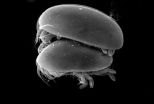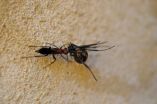(Press-News.org) The small ostracod Ankylocythere sinuosa measures no more than half a millimetre in length and lives on other crayfish. And, Spanish scientists have discovered it for the first time in Europe. The finding suggests that it arrived along with the invader crayfish Procambarus clarkii some 30 years ago but it is still unknown whether it can invade other crustacean species or whether it benefits or damages the expansion of the already established red swamp crayfish.
The red swamp crayfish (Procambarus clarkii) originates from the USA and Mexico and has been present in the Iberian Peninsula since the 1970's. Its expansion is currently on the up. However, its 'invasion' is coupled with that of another species: the ostracod Ankylocythere sinuosa, which is also from North America and totally relies on the crayfish to survive. It has now been discovered in Europe but could have come at the same time as its host 30 years ago.
Published in the 'Hydrobiologia' journal, the study aimed to verify how the Ankylocythere sinuosa arrived on the European Continent. According to researchers, although it has taken more than three decades to discover, "it is certain that it arrived with Procambarus clarkii".
"Ankylocythere sinuosa is common and abundant wherever there is the red swamp crayfish in Europe", as explained to SINC by Francesc Mesquita Joanes, lead author of the study and researcher at the Department of Microbiology and Ecology of the University of Valencia.
This minute epibiont crustacean lives on top of its host meaning it cannot live without the crayfish. It lays its eggs on the crayfish and clings on while it develops. The majority of crayfish are infected and "adult specimens can have up to many hundreds of ostracods on them," reveals Mesquita.
Hundreds of tiny crabs on the back of a crayfish
Between 2003 and 2009, the team of researchers took 203 red swamp crayfish from 12 different regions of the Iberian Peninsula from Doñana in the southwest to Catalonia in the northeast. In total, 147 of them had ostracods, which were present in practically all sampled regions.
"We have to remember that these epibionts can spread to other native species."
Through comparison with the crayfish living on the USA, the scientists have also discovered that Procambarus clarkii travelled with just this small crustacean on its back. The biologist outlines that "the crayfish did not transport all the possible epibionts present in its place of origin. Although P. clarkii could be infected with other epibiont ostracods in North America, it only brought with it one species to Europe."
The scarce diversity of these crustaceans could help its greater expansion in invaded areas. "We have to remember that these epibionts could spread to other native species," warns Mesquita-Joanes, outlining that it is necessary to study if the ostracod have any sort of effect on Aphanomyces, the plague of crayfish that is causing the extinction of native species.
An invasion for better or for worse
But, what does the presence of Ankylocythere sinuosa in crayfish mean?. The scientists are still unsure. For now, "they seem to basically be just guests and do neither good nor bad to the crayfish. But this is debatable," says the expert to SINC.
For the researcher, the ostracods could do good if they 'clean' parasites or organic material in contaminated areas or they could do harm if they feed off any part of the crayfish or the eggs of the female.
Awaiting new studies that confirm the effects of this relationship, the authors suggest that the ostracod could also spread to other invading or native crayfish, but the results are not very specific and there could be still unknown effects.
INFORMATION:
Reference:
Aguilar-Alberola, J. A.; Mesquita-Joanes, F.; López, S.; Mestre, A.; Casanova, J. C.; Rueda, J.; Ribas, A. "An invaded invader: high prevalence of entocytherid ostracods on the red swamp crayfish Procambarus clarkii (Girard, 1852) in the Eastern Iberian Peninsula" Hydrobiologia 688(1): 63-73 DOI: 10.1007/s10750-011-0660-1 2012.
A minute crustacean invades the red swamp crayfish
The invader of the invader has been discovered for the first time in Europe
2012-09-11
ELSE PRESS RELEASES FROM THIS DATE:
Dartmouth research imparts momentum to mobile health
2012-09-11
Electronic Jewelry for Health
Bracelets and amulets are in the works at Dartmouth's Institute for Security, Technology, and Society (ISTS). Rather than items of mere adornment, the scientists and engineers are constructing personal mobile health (mHealth) devices—highly functional jewelry, as it were.
mHealth is a rapidly growing field where technology helps you or your physician monitor your health through mobile devices. This approach can offer more accurate and timely diagnoses as well as lower health costs. However, smartphones are often used to transmit collected ...
Aussie wasp on the hunt for redback spiders
2012-09-11
University of Adelaide researchers say a small wasp that scientists had forgotten about for more than 200 years is now making a name for itself – as a predator of Australia's most common dangerous spider, the redback.
The wasp (Agenioideus nigricornis) was first described scientifically in 1775 by Danish entomologist Johan Christian Fabricius, thanks to samples collected in Australia during Captain Cook's first great voyage (1768).
"Since then, scientists have largely forgotten about the wasp," says Professor Andy Austin from the University of Adelaide's Australian ...
Diet could combat adverse side-effects of quinine
2012-09-11
Scientists at The University of Nottingham say adverse side-effects caused by the anti-parasitic drug quinine in the treatment of malaria could be controlled by what we eat.
The research, carried out by Nottingham scientists on the University's campuses in the UK and Malaysia, indicates that natural variation in our levels of the amino acid, tryptophan, has a marked bearing on how we respond to quinine treatment. It appears that the lower our levels of tryptophan the more likely it is that we would suffer side-effects. And because tryptophan is an essential amino acid ...
A study analyzes the search for information in stock photography agencies
2012-09-11
VIDEO:
Research carried out at Universidad Carlos III in Madrid analyzes the search and visualization systems used by commercial stock photography agencies, whose estimated annual net sales reach over 150 billion...
Click here for more information.
Stock photography agencies, and not just those companies that dominate the digital photography market, are at the forefront of information search tools. "Their search, visualization and information downloading systems are extraordinarily ...
Vitamin C and beta-carotene might protect against dementia
2012-09-11
Forgetfulness, lack of orientation, cognitive decline… about 700, 000 Germans suffer from Alzheimer's disease (AD). Now researchers from the University of Ulm, among them the Epidemiologist Professor Gabriele Nagel and the Neurologist Professor Christine von Arnim, have discovered that the serum-concentration of the antioxidants vitamin C and beta-carotene are significantly lower in patients with mild dementia than in control persons. It might thus be possible to influence the pathogenesis of AD by a person's diet or dietary antioxidants. 74 AD-patients and 158 healthy ...
Risk-glorifying video games may lead teens to drive recklessly, new research shows
2012-09-11
WASHINGTON -- Teens who play mature-rated, risk-glorifying video games may be more likely than those who don't to become reckless drivers who experience increases in automobile accidents, police stops and willingness to drink and drive, according to new research published by the American Psychological Association.
"Most parents would probably be disturbed to learn that we observed that this type of game play was more strongly associated with teen drivers being pulled over by the police than their parenting practices," said study lead author Jay G. Hull, PhD, of Dartmouth ...
Review: Altruism's influence on parental decision to vaccinate children is unclear
2012-09-11
INDIANAPOLIS -- As outbreaks of preventable diseases such as whooping cough and measles increase in the United States, researchers from the Regenstrief Institute and Indiana University School of Medicine are investigating whether altruism, known to influence adults' decisions to immunize themselves, influences parental decisions to vaccinate their children.
"If enough people are immunized against a particular disease, it prevents outbreaks of that disease and protects the community. This is known as herd immunity, and it's a very important benefit of childhood immunization," ...
Dengue Vaccine Initiative welcomes latest progress in vaccine development
2012-09-11
WASHINGTON, D.C.—September 11, 2012—Today, The Dengue Vaccine Initiative (DVI) welcomed new clinical trial results that reveal progress in developing the first-ever dengue vaccine. In a publication in The Lancet, pharmaceutical company Sanofi Pasteur reported results from the first study conducted to evaluate the efficacy of any dengue vaccine candidate against clinical dengue disease in a population naturally exposed to dengue.
Dengue vaccine development efforts have been difficult because dengue is caused by four different related viruses, known as DENV 1, 2, 3 and ...
LSUHSC research finds ginkgo biloba doesn’t improve cognitive function in MS
2012-09-11
New Orleans, LA – A research study conducted by Dr. Jesus Lovera, Assistant Professor of Neurology at LSU Health Sciences Center New Orleans, and colleagues has found that the herbal supplement Ginkgo biloba does not improve cognitive function in patients with Multiple Sclerosis (MS.) Cognitive impairment affects 40-60% of people with MS, most commonly affecting their processing speed, memory, and executive skills. The research findings were published online ahead of print in Neurology on September 5, 2012.
This study followed up on a promising earlier small study by ...
Who (and what) can you trust?
2012-09-11
People face this predicament all the time—can you determine a person's character in a single interaction? Can you judge whether someone you just met can be trusted when you have only a few minutes together? And if you can, how do you do it? Using a robot named Nexi, Northeastern University psychology professor David DeSteno and collaborators Cynthia Breazeal from MIT's Media Lab and Robert Frank and David Pizarro from Cornell University have figured out the answer. The findings were recently pub¬lished in the journal Psychological Science, a journal of the Association for ...
LAST 30 PRESS RELEASES:
Plant hormone allows lifelong control of proteins in living animal for first time
Swedish freshwater bacteria give new insights into bacterial evolution
Global measures consistently underestimate food insecurity; one in five who suffer from hunger may go uncounted
Hidden patterns of isolation and segregation found in all American cities
FDA drug trials exclude a widening slice of Americans
Sea reptile’s tooth shows that mosasaurs could live in freshwater
Pure bred: New stem cell medium only has canine components
Largest study of its kind highlights benefits – and risks – of plant-based diets in children
Synergistic effects of single-crystal HfB2 nanorods: Simultaneous enhancement of mechanical properties and ablation resistance
Mysterious X-ray variability of the strongly magnetized neutron star NGC 7793 P13
The key to increasing patients’ advance care medical planning may be automatic patient outreach
Palaeontology: Ancient tooth suggests ocean predator could hunt in rivers
Polar bears may be adapting to survive warmer climates, says study
Canadian wildfire smoke worsened pediatric asthma in US Northeast: UVM study
New UBCO research challenges traditional teen suicide prevention models
Diversity language in US medical research agency grants declined 25% since 2024
Concern over growing use of AI chatbots to stave off loneliness
Biomedical authors often call a reference “recent” — even when it is decades old, analysis shows
The Lancet: New single dose oral treatment for gonorrhoea effectively combats drug-resistant infections, trial finds
Proton therapy shows survival benefit in Phase III trial for patients with head and neck cancers
Blood test reveals prognosis after cardiac arrest
UBCO study finds microdosing can temporarily improve mood, creativity
An ECOG-ACRIN imaging study solves a long-standing gap in metastatic breast cancer research and care: accurately measuring treatment response in patients with bone metastases
Cleveland Clinic presents final results of phase 1 clinical trial of preventive breast cancer vaccine study
Nationally renowned anesthesiology physician-scientist and clinical operations leader David Mintz, MD, PhD, named Chair of the Department of Anesthesiology at the UM School of Medicine
Clean water access improves child health in Mozambique, study shows
Study implicates enzyme in neurodegenerative conditions
Tufts professor named Fellow of the National Academy of Inventors
Tiny new device could enable giant future quantum computers
Tracing a path through photosynthesis to food security
[Press-News.org] A minute crustacean invades the red swamp crayfishThe invader of the invader has been discovered for the first time in Europe




